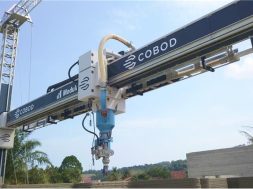Connected Construction unlocks productivity

A Complete Transformation of the Construction Industry.
Construction has the largest productivity gap of all the main global industries. According to well-known McKinsey research, over two decades, labour productivity growth in the construction industry averaged just 1 percent annually, compared to the global economy’s 2.8 percent annual increase. During that same period, the manufacturing industry saw an average increase in worker productivity of 3.6 percent annually.
These numbers confirm a long-standing worry of the participants in the construction sector regarding diminishing project profits despite skyrocketing wages and other expenses. Reducing this inequality is essential for long-term growth and development because the building industry is so important to our social, economic, and urban settings.
In a dynamic and complicated global economy, the construction sector must increase productivity and efficiency to remain competitive. To do this, project management procedures must be made more efficient, and a continual innovation culture must be promoted. Above all, to maximise production, the sector must aggressively adopt the most recent technological developments to enhance and optimise its operations. A crucial first step in this path is adopting connected construction, a new tech-enabled method of construction.
Decoding connected construction:
There is no denying that the industry’s digital transformation has been made possible by the integration of drawing, Building Information Modelling (BIM), and project management software. But only when these tools are integrated via a shared data environment can their full potential be realised, enabling a smooth construction workflow from project planning to project handover.
Project managers, contractors, and other stakeholders can gain unprecedented visibility and insight into the planning, designing, and construction processes of a building thanks to this interconnectivity among various software, hardware, and even project stakeholders, all contained within a single 3D BIM model of the structure under construction.
First and foremost, building industry professionals need to understand that, even though BIM technologies have a significant impact, they cannot advance the sector by themselves by generating new productivity benefits. Rather, it becomes clear that the Connected Construction method is a key factor in bringing construction to new productivity levels. An information-rich BIM model is essential to connected construction; it needs to be shared and helpful to the field personnel working on a project, in addition to being easily available.
The Connected Advantage:
Essentially, connected construction tackles the common problem of decision-making for a project being disjointed due to silos around different trades involved in a project, which impedes continuous efficiency advances. It frequently happens that the various stages and trades that make up a big project run entirely independently of one another, which results in inefficiencies. These silos are successfully broken down by connected construction, which also integrates all of the moving components of the intricate construction workflow. Project execution advances automatically through the total elimination of bottlenecks resulting from a lack of shared knowledge. Moreover, the consistent integration of all stakeholders across all stages of the project plays a major role in boosting supply chain productivity. Connected Construction seeks to optimise results and expedite project completion dates by cutting down on processes, avoiding delays, and promoting teamwork.
Interoperable Connectivity:
Connected Construction is centred on a Common Data Environment (CDE) for all trades and stakeholders. Open and shared data not only guarantees real-time collaboration but also makes it easier for all stakeholders to share accurate and current knowledge. As a result, there are notable productivity improvements as all stakeholders collaborate as a single composite force to drive project execution ahead with a single, shared vision.
In a connected construction ecosystem, where large volumes of data are transferred quickly and continuously, interoperability naturally becomes the cornerstone. Different hardware and software tools and technologies from various vendors can freely share data and work together thanks to interoperability. Standards for interoperability across different construction tools and technology are actively being developed by several industry organisations. By creating a more connected and efficient future for the construction sector, this coordinated initiative hopes to establish a unified environment where varied technologies can merge.
Interoperability and connectivity are also in line with several automation technologies that are significantly increasing construction productivity. One example is digitally automated fabrication. Digital fabrication, driven by shared models, does away with the need to replicate projects and build data throughout the fabrication phase. Rather, work proceeds smoothly, led throughout the project’s lifetime by these common models. This convergence of automation and connection is a critical step in improving productivity in the construction industry.
Navigating the Future of Construction Technology:
The global acceptance of IoT, Big Data, AI, and cloud computing is also contributing to the strong growth of connected construction. A Common Data Environment may be created and used thanks to all of these technologies. Project managers can now make well-informed decisions more quickly, saving a significant amount of money and effort thanks to an ongoing flow of data from linked devices.
Along with integrating advanced analytics tools and Building Information Modelling (BIM), Connected Construction provides enhanced project insights, minimises errors via sophisticated clash detection, and optimises project lifecycles in their entirety. A new benchmark for accuracy and productivity in building processes is set by the combination of analytics and modelling. Robotics, wearables, and smart equipment all play a big part in improving accuracy and safety on building sites. Unprecedented precision in construction operations is ensured by drones, self-driving cars, and wearable sensors that reduce human exposure to dangerous settings. The construction industry’s ethos is being shaped by a comprehensive revolution that goes beyond mere technological change, as evidenced by the rise of Connected Construction. A more connected, efficient, and responsible future in construction is paved with this revolution, which includes real-time data empowerment, advanced analytics, precision-enhancing technologies, and an unwavering dedication to sustainability. Opportunities for innovation, cooperation, and long-term influence are endless as the sector leads this revolutionary path.
For more info visit : https://www.trimble.com/en
83
Cookie Consent
We use cookies to personalize your experience. By continuing to visit this website you agree to our Terms & Conditions, Privacy Policy and Cookie Policy.










